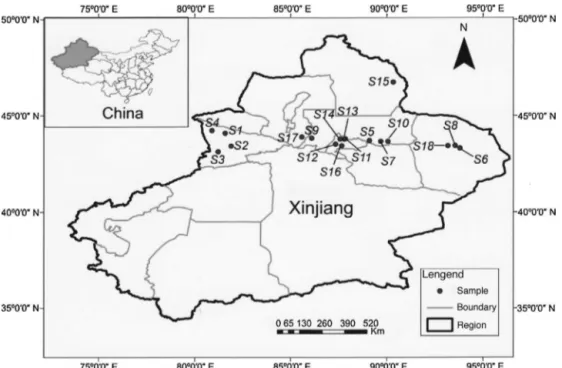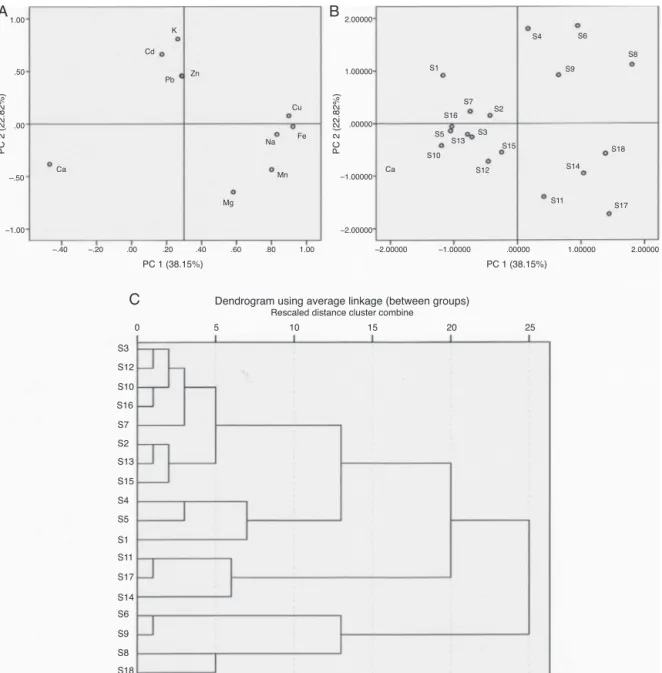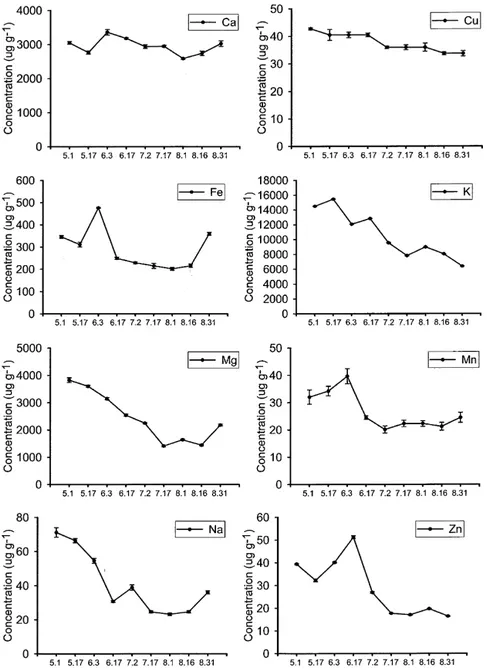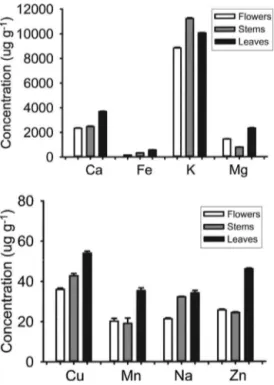w w w . s b f g n o s i a . o r g . b r / r e v i s t a
Original
Article
Multi-elemental
analysis
of
Ziziphora
clinopodioides
from
different
regions,
periods
and
parts
using
atomic
absorption
spectrometry
and
chemometric
approaches
Xuejia
Zhang
a,e,
Wenhuan
Ding
b,
Jie
Li
a,
Feng
Liu
c,
Xiaoying
Zhou
d,
Shuge
Tian
a,b,∗aCollegeofTCM,XinjiangMedicalUniversity,Urumqi,Xinjiang,China bCentralLaboratoryofXinjiangMedicalUniversity,Urumqi,Xinjiang,China
cCollegeofChemistryandChemicalEngineering,XinjiangNormalUniversity,Urumqi,Xinjiang,China dCollegeofPharmacy,XinjiangMedicalUniversity,Urumqi,Xinjiang,China
eChinaPharmaceuticalUniversity,Nanjing,Jiangsu,China
a
r
t
i
c
l
e
i
n
f
o
Articlehistory:
Received28December2014 Accepted22July2015
Availableonline4September2015
Keywords:
Ziziphoraclinopodioides Traceelements
Atomicabsorptionspectrometry Chemometricapproaches Diversity
Variationanddistribution
a
b
s
t
r
a
c
t
In this study, ten trace elements in Ziziphora clinopodioides Lam., Lamiaceae, from different
regions, periods and parts in Xinjiang were determined by atomic absorption spectrometry
following microwave-assisted acid digestion. The decreasing sequence of elements levels was
K>Ca>Mg>Fe>Cu>Zn>Na>Mn>Cd>Pb.Chemometricapproaches,suchascorrelationanalysis,
prin-cipalcomponentanalysis,andhierarchicalclusteranalysiswereappliedtoclassifyZ.clinopodioides
accordingtoitselementscontents.Principalcomponentanalysisrevealed83.51%ofthevariancewith
thefirstfourprincipalcomponentvariables.Hierarchicalclusteranalysisindicatedfivegroupsfromthe
eighteenregions,andtheresultofclassificationcancorrespondtothegeographicaldistributionforthe
mostregions.Variationintheelementsexhibitedadecreasingtrend,butofdifferenttypesinthestudied
periods.Elementalcontentsdistributedinleaveswerehigherthanthoseinflowersandstems.Therefore,
chemometricapproachescouldbeusedtoanalyzedatatoaccuratelyclassifyZ.clinopodioidesaccording
toorigins.Thisstudyprovidedsomeelementalinformationonchemotaxonomy,diversity,changing
pat-tern,distribution,andmetabolismofZ.clinopodioidesatspatialandtemporallevels,andcouldbeused
asareferenceofplantingandqualitystandards.
©2015SociedadeBrasileiradeFarmacognosia.PublishedbyElsevierEditoraLtda.Allrightsreserved.
Introduction
ZiziphoraclinopodioidesLam.,aperennialplantbelongingtothe Lamiaceae,isawellknowntraditionalUyghurmedicinalherbfrom Xinjiang,China.Infolksociety,freshanddryZ.clinopodioideshas beenused as spice in noodle and tea. Moreover,this aromatic plantisrich in essentialoil, which isappliedin food,perfume, andmedicaltreatments,thus,localpeoplecallZ.clinopodioidesas “wildpeppermint.”Thisplantisalsousedtotreathypertension, fever, edema, heart disease, neurasthenia, insomnia, tracheitis, lungabscess,andhemorrhoids(Liuetal.,1999;Senejouxaetal., 2010).Other ethnobotanical uses of Ziziphora species as stom-achic,carminativeandwoundhealingmaterialhavebeenrecorded inIranianandTurkishfolkmedicines(Meraletal.,2002;Ozturk
∗ Correspondingauthor. E-mail:tsgyz@sina.com(S.Tian).
and Ercisli, 2007).Previous pharmacological investigations also revealedthatthisspecies exhibitsantimicrobial(Jietal.,2012), antifungal(Behravanetal.,2007),antioxidative(Tianetal.,2011), andanti-hypertensive(Guoetal.,2014)propertiesattributedto itsessentialoil.Phytochemicalinvestigationshaveshownthatthis genusisasourceofflavonoids,polyphenols,polysaccharides,fatty acidsand sterols(Yuetal.,2012).Theherbalsobiosynthesizes phenolic compounds, suchas caffeic acid, rosmarinic acid, and flavonoidderivatives,includingluteolin,linarin,diosmin,and thy-monin(Yangetal.,2008;Tianetal.,2012).Moreover,thisaromatic plantisrichinessentialoil.Pulegone,trans-isopulegone,menthol, 1,8-cineoleandlimonenewerefoundtobethemajorcomponents ofZ.clinopodioidesessentialoil(Dingetal.,2014a,b).
Traceelementsplayanimportantroleinanorganism’s biolog-icalactivities.Inplants,traceelementsareimplicatedinseveral physiologicalactivities,includingmetabolismandbiosynthesis,as wellasenzymecofactors(Maigaetal.,2005).Traditionalmedicine playsanimportantroleinthegeneralhealthstatusofa popula-tion,andthedemandformedicinalherbsanditsproductshave
http://dx.doi.org/10.1016/j.bjp.2015.07.021
Figure1. GeographicaldistributionofthecollectedZ.clinopodioidessamplesinXinjiang,China.
continuouslyincreased.However,healthriskisposedbyvarious medicinalherbs and theirproductsbecause ofthe presence of toxicelements.Thehumanbodyrequiresmetallicand nonmetal-licelementswithincertainpermissiblelimitsforgrowthandgood health.Assuch,varioustraceelementconcentrations shouldbe quantitativelyestimatedtoevaluatetheeffectivenessofmedicinal plantsforthetreatmentofvariousdiseasesandunderstand phar-macologicalactivities(Tokalıoglu,2012).Superiorqualitycontrol formedicinalherbsshouldbeimplementedtoprotectconsumers fromcontamination.Varioustechniques,suchasatomic absorp-tionspectrometry(AAS)(WangandLiu,2010),inductivelycoupled plasmaopticalemissionspectrometry(ICP-OES)(Liuetal.,2014), inductivelycoupledplasma-massspectrometry(ICP-MS)(Buetal., 2013),andX-rayfluorescence(XRF)(Kierdorfetal.,2014),areused toanalyzetraceelementsinmedicinalherbs.AASasrapid and accuratetechniqueforthispurposewaschosenforthepresented work.
Thisstudyaimedtodeterminetentraceelements(Ca,Cd,Cu, Fe,K,Mg,Mn,Na,Pb,andZn)inZ.clinopodioidessamplesfrom dif-ferentregions,periodsandpartsinXinjiang,China.Theseelements weredeterminedbyflameandgraphitefurnaceatomicabsorption spectrometry,aftermicrowave-assisted aciddigestion was per-formed.Toprovidebetterinsightsintothepatternsofelements,we performedcommonchemometricapproaches,suchascorrelation analysis(CA),principalcomponentanalysis(PCA),and hierarchi-calclusteranalysis(HCA),asclassificationtechniquestoevaluate data.Semi-monthlyvariationofelementalconcentrationsandthe distributionofelementsinleaves, flowersandstemswerealso investigated.
Materialsandmethods
Reagentsandmaterials
Allofthereagentsusedthroughouttheexperimentswereof analytical-reagentgrade.UltrapuregradeHNO3 (65%)andH2O2
(37%) were purchased from Tianjin Chemical Co., Ltd., China. Double-deionizedwaterwasproducedusingMilliQwater purifica-tionsystem(Millipore,Bedford,MA,USA).Thestandardsolutions ofCa,Cd,Cu,Fe,K,Mg,Mn,Na,Pb,andZnwereobtainedfromthe
NationalResearchCenterforCertifiedReferenceMaterial(CRM)of China(NRCCRM),andusedtopreparethestocksolution.Glassware andTeflondigestionvesselswerecleanedbysoakingovernightin dilutedHNO3(1/9,v/v)andbysubsequentlyrinsingwith
double-deionizedwateranddryingbeforeuse.
Instruments
AHitachiZ-2000atomicabsorptionspectrometer(HitachiCo., Ltd.,Japan)equippedwithamulti-elementalhollowcathodelamp andaDeuteriumandZeemanbackgroundcorrectionsystemwere usedtodeterminateoftraceelements.Thisequipmentwas oper-atedusinganair/acetyleneflameandtransverse-heatedgraphite furnace controlled bya personal computer. Operating parame-tersoftheworkingconcentrationsofelementsweresetaccording tomanufacturer’srecommendation.Eachsamplewasreadthree timestoobtainameanvalue.Concentrationwascorrectedonthe basisofvolumeofacidusedinsamplepreparation.
A Sineo MDS-6 closed vessel microwave digestion system (Shanghai EU Analytical Instrument Co., Ltd., China) was used forextraction.Teflonreactionvesselswereusedforalldigestion procedures.Operatingparametersweresetaccordingtothe man-ufacturer’srecommendations.
Procedure
EighteensamplesofZiziphoraclinopodioides Lam.,Lamiaceae, werecollectedineighteendifferentregionsinXinjiang(Fig.1)in July2013.Ninesampleswerecollectedsemi-monthlyduringMay toAugustfromonestationaryplace,oneofthesampleswasdivided intothreeparts(flowers,stems,andleaves)forstudy.Allofthe sampleswereidentifiedbyYongheLi,achiefapothecaryofthe ChineseMedicineHospitalofXinjiang,China.Thesesampleswere washedwithdouble-deionizedwaterandthenoven-driedat60◦C.
Driedsamplesweregrindedandhomogenizedusinga homoge-nizer.Afterward,thesesampleswerescreenedwitha200mesh sieveandstoredinplasticbags.
Table 1 Concentrations of elements in Ziziphora clinopodioides samples from different geographical regions. a No. Ca ( g g − 1) Cu ( g g − 1) Zn ( g g − 1) Fe ( g g − 1) K ( g g − 1) Mg ( g g − 1) Mn ( g g − 1) Na ( g g − 1) Cd (ng g − 1) Pb (ng g − 1) S1 2980.17 ± 63.61 54.01 ± 1.12 36.18 ± 0.57 497.05 ± 6.12 11,553.67 ± 40.80 958.83 ± 22.77 17.99 ± 1.73 9.46 ± 0.35 0.73 ± 0.02725 0.03 ± 0.00094 S2 3152.59 ± 57.66 67.51 ± 1.87 79.61 ± 0.60 538.27 ± 12.76 9943.50 ± 37.09 3346.24 ± 38.34 19.07 ± 1.32 23.72 ± 0.36 0.11 ± 0.00403 0.02 ± 0.00070 S3 2911.21 ± 17.86 60.76 ± 0.96 46.05 ± 0.26 778.72 ± 11.08 8333.33 ± 13.43 2700.99 ± 22.38 20.16 ± 0.91 24.19 ± 0.77 0.73 ± 0.03925 0.02 ± 0.00013 S4 3575.00 ± 29.87 74.26 ± 5.42 117.11 ± 0 94 1067.26 ± 30.18 12,090.40 ± 52.28 2926.83 ± 46.78 20.16 ± 0.81 26.09 ± 0.64 4.69 ± 0.13336 0.03 ± 0.00069 S5 3497.41 ± 54.36 60.76 ± 1.27 37.50 ± 0.49 552.01 ± 16.93 11,045.20 ± 56.94 2507.42 ± 27.73 14.74 ± 0.33 17.54 ± 0.83 0.11 ± 0.00503 0.01 ± 0.00002 S6 1643.97 ± 28.38 83.26 ± 1.47 63.82 ± 0.14 1218.40 ± 30.79 13,361.58 ± 22.18 2120.27 ± 39.31 21.24 ± 1.33 105.91 ± 0.49 3.65 ± 0.20757 0.02 ± 0.00016 S7 2023.28 ± 20.28 63.01 ± 0.73 62.50 ± 0.16 421.48 ± 4.18 9378.53 ± 19.06 2507.42 ± 2.79 13.65 ± 1.10 15.64 ± 0.66 ND 0.01 ± 0.00019 S8 1083.62 ± 13.87 78.76 ± 1.09 53.95 ± 0.23 2674.84 ± 16.97 11,807.91 ± 59.67 3249.45 ± 36.21 60.28 ± 1.94 70.76 ± 0.66 4.07 ± 0.19586 0.03 ± 0.00048 S9 1626.72 ± 34.41 72.01 ± 1.09 44.74 ± 0.33 1726.78 ± 10.16 13,192.09 ± 48.98 2410.63 ± 16.79 31.00 ± 0.72 68.38 ± 2.24 ND 0.02 ± 0.00020 S10 3135.34 ± 43.44 58.51 ± 0.87 32.89 ± 0 42 421.48 ± 6.01 8983.05 ± 27.78 1991.22 ± 1.87 17.99 ± 1.54 18.97 ± 0.29 ND 0.01 ± 0.00021 S11 3118.10 ± 36.82 69.76 ± 1 79 44.74 ± 0.16 1445.11 ± 11.24 8926.55 ± 49.67 5604.59 ± 38.37 37.51 ± 1.73 58.40 ± 0.89 ND 0.01 ± 0.00042 S12 2721.55 ± 38.74 65.26 ± 1.50 38.82 ± 0.34 778.72 ± 19.60 8474.58 ± 55.95 3055.88 ± 8.85 36.42 ± 2.64 26.57 ± 0.47 1.36 ± 0.13932 ND S13 2704.31 ± 75.54 56.26 ± 3.04 59.87 ± 0.45 476.44 ± 5.42 9943.50 ± 35.20 2700.99 ± 15.18 28.83 ± 2.17 27.04 ± 1.59 0.53 ± 0.01022 ND S14 3075.00 ± 25.74 74.26 ± 1.13 54.61 ± 0.69 1184.05 ± 9.85 7937.85 ± 25.32 4281.84 ± 61.45 49.44 ± 1.20 138.70 ± 1.13 ND 0.04 ± 0.00091 S15 2307.76 ± 16.17 69.76 ± 1.53 13.16 ± 0.19 991.69 ± 11.17 10,480.23 ± 24.96 3055.88 ± 21.96 32.09 ± 0.74 32.75 ± 0.28 0.32 ± 0.01472 ND S16 2756.03 ± 14.79 47.25 ± 1.38 29.61 ± 0.08 579.49 ± 6.35 9039.55 ± 44.11 2249.32 ± 56.68 29.92 ± 1.92 33.22 ± 1.08 3.86 ± 0.09100 ND S17 3040.52 ± 39.78 83.26 ± 2.17 44.74 ± 0.23 2008.45 ± 14.65 9124.29 ± 15.80 5507.81 ± 91.30 72.21 ± 1.54 80.73 ± 1.45 ND 0.01 ± 0.00022 S18 2307.76 ± 46.22 76.51 ± 3.70 71.71 ± 0.53 2441.26 ± 24.64 10,564.97 ± 26.68 3443.02 ± 72.32 67.87 ± 0.23 85.96 ± 1.30 ND ND Mean 2647 . 80 67 . 51 51 . 75 1100 . 08 10 , 232 . 27 3034 . 37 32 . 81 48 . 00 1.12 0.01 a Results were mean ± standard deviation obtained from three replicates of one sample. ND: not detected.
ofafreshlypreparedmixtureofconcentratedHNO3–H2O2(7,1,v/v)
wasaddedtothevesselandkeptatroomtemperaturefor10min. Thedigestionconditionsforthemicrowavesystemwereapplied asfollows:(1)400Wat90◦Cfor2min,and(2)400Wat120◦Cfor
8min.Afterambienttemperaturewasreached,thereactorswere openedtoeliminatenitrousvapors.Theundissolvedpartswere separatedbycentrifugationat1788.8×gfor5min.Theextractwas transferredtoavolumetric flaskandfinal volumeof50ml was obtainedbyadding double-deionizedwater. Blankexperiments (n=3)werecarriedoutinthesameway.
Tenelements(Ca,Cd,Cu,Fe,K,Mg,Mn,Na,Pb,andZn)were determinedinthisstudy.Ca,Cu,Fe,K,Mg,Mn,Na,andZnionswere determinedinanair/acetyleneflame.CdandPbionswere deter-minedusingagraphitefurnaceatomicabsorptionspectrometer (GFAAS).Theoperatingparametersfortheworkingconcentrations oftheelementsweresetasrecommendedbythemanufacturer. Eachsamplewasreadthreetimestoobtainameanvalue. Concen-trationwascorrectedforthevolumeofacidusedinthesample preparation.
Dataanalysis
StatisticaldataanalysiswasperformedusingSPSS19.0software forWindows.Chemometricapproacheswereusedtoevaluate ele-mentaldatawidely(WangandLiu,2010),suchasCA,PCA,andHCA, toanalyzedifferencesintraceelementpatternsinZ.clinopodioides
samples.
Resultsanddiscussion
Elementalcontentofdifferentgeographicalregions
Table 1 lists the average results of the elemental contents obtainedfromtriplicateanalysesbyAASmethod.Theaverage con-tent of theelements in the studiedZ. clinopodioides decreased inthefollowingorder,K>Ca>Mg>Fe>Cu>Zn>Na>Mn>Cd>Pb. Thisresultwassimilartothatinapreviousstudy(Tianetal.,2009). Ingeneral,traceelementsinplantsaremainlyobtainedfromsoil (Russell,1979).DifferentZ.clinopodioidessamplesvariedonthe basisofelementalcontent.Atotalofeighteensampleswere col-lectedfromdifferentregionsalong TianshanMount inXinjiang, andeachofthemwasplacedawayfromoneanotheratalong dis-tance.Thesoilsonthismountaindifferbecauseofthecomplex structureandgeographicalenvironmentofTianshanMountain(Ma etal.,2014).Variousreportshaverevealedthesameconclusions astheresultofthisstudy(Shietal.,2009).Ourresultswerealso affectedbyotherfactors,suchasclimate,humans,orotherplants. Forexample,sample4containedCdandPblevelshigherthanthe othersamples.Toourknowledge,themajorreasonisbecausean importanthighwaythatcrossesthedistributionofsample4. Exces-siveamountsofautomobileexhaustinducedtheaccumulationof heavymetalsinsoilandthisexhaustwasabsorbedbyZ. clinopodi-oides.Onthecontrary,samples7,10,11,13,15,and17contained lowerlevelsofCdandPbbecauseoflesshumanactivity.
Correlationanalysis
Table2
CorrelationmatrixfortheelementalconcentrationsinZiziphoraclinopodioides.a
Ca Cu Zn Fe K Mg Mn Na Cd Pb
Ca 1.000
Cu −0.357 1.000
Zn 0.113 0.371 1.000
Fe −0.510* 0.753** 0.147 1.000
K −0.471* 0.341 0.283 0.292 1.000
Mg 0.174 0.537* 0.092 0.491*
−0.412 1.000
Mn −0.256 0.578*
−0.027 0.842**
−0.140 0.652** 1.000
Na −0.335 0.712** 0.113 0.645** 0.088 0.477* 0.643** 1.000
Cd −0.239 0.115 0.360 0.154 0.410 −0.242 −0.042 0.046 1.000
Pb −0.050 0.294 0.435 0.137 0.247 −0.034 −0.078 0.317 0.186 1.000
apvalues. * Meansp<0.05. ** Meansp<0.01.
C.c.>0.5(or<−0.5)wasusedtointerpretcorrelationanalysis results.However,somevaluescloseto±0.5werealsoincludedto producegroupingssuchas0.491forMgandFeand−0.471forCa andK.Significantcorrelationbetweentwoormoreelements indi-catessimilarabilitytoenterZ.clinopodioidesorthepresenceofthe samesource.HighcorrelationswerefoundamongNa,Cu,Fe,Mg, andMnwithc.c.between0.491and0.842.Dependencybetween theseelementscan beexplained by thecommon originof the soilminerals.Inaddition,thestrongestcorrelationwasobserved betweenMnandFe(c.c.=0.842).However,Cawasnegatively cor-relatedwithFeandK(c.c.=−0.510andc.c.=−0.471,respectively). Correlationcoefficientmethodprovidesinformationthatcould onlyindicatethesamesourceorbehaviorfortwo ormore ele-ments,whereasinformationonthedifferencesbetweensamples fromthedifferentregionscannotbeprovided.Further interpreta-tionsbetweenelementsandregionsmaybeobtainedusingmore powerfulchemometrictechniques,suchasPCA.
Principalcomponentanalysis
Inordertohighlighttherelationshipsbetweenelements,we subjectedtheentiredatasettoPCA.PCAcouldalsobeperformed ontheconcentrationsofelementstoenableadiscriminationof thesamples.Thefirstfourprincipalcomponentswereextracted andexplained83.51% ofthetotalvariabilityamongthe10 vari-ables.Fig.2Ashowstheloadingplot(PC1versusPC2)whereCu, Fe,Mn,andNapredominatedinthehigherpositivevaluesofPC 1andexplained38.15%ofthetotalvariance.Onthecontrary,Ca exhibitedconsiderablynegativevaluesinthePC1becauseCawas negativelycorrelatedwiththeseelements.KandCdelicitedthe highesteffectonPC2andaccountedfor22.82%ofthetotal vari-ance.MgnegativelycorrelatedwithPC2.Thethirdcomponentwas correlatedwithZnandCa.Basedonthescoresonthefirst princi-palcomponent,Cu,Fe,Mn,andNacontentsonthefirstprincipal componentloadingswerehigherinsample8,9,14,17,and18than intheothersamples;bycontrast,Cu,Fe,Mn,andNacontentson thefirstprincipalcomponentloadingwerelowerinsamples1,10, 13,and16thanintheothersamples.Basedonthescoresofthe secondprincipalcomponent,KandCdconcentrationswerehigher insamples4,6,and8butlowerinsamples10,11,and14thanin theothersamples.
Thefirsttwovarimaxrotatedprincipalcomponentloadingsand scoresareshowninFig.2.Theloadingsindicatedthesimilarities andcorrelationsbetweenthetwoelements.Elementswithhigh loadingsgreatlyinfluencedonthegroupingandtheseparationof samples;bycontrast,elementswithsmallloadingsslightly influ-enceddatastructure.InFig.2A,anassociationbetweenCu,Fe,Mn, andNawasapparent.Anotherassociationwasobservedbetween KandCdonthePC2,whereasCaandMgappearedmoredispersed
intothecomponentspaceandshowedamoreindividualized char-acteristic.ThescoresinFig.2Bindicatedthesimilaritiesandthe correlationsbetweentwosamples.Thepointsintheanomalous positions6,8,9,14, 17,and18 wereoutliers,in particular,the sample6and17containedthehighestCu,whereassamples6and 9containedthelowestCa(Table1);Sample8and18containedthe highestFe,whereassample14containedthehighestNa(Table1).
Hierarchicalclusteranalysis
HCAisoneofthemostwidelyusedunsupervisedpattern recog-nitiontechniquesinchemometrics.Inthistechniquerelationships betweensamples are determinedwithout usingprior informa-tionpertainingtotheserelationships.HCAwasappliedusingSPSS 19.0.In this study,Ward’smethodof clusteringwasappliedto thesquaredEuclideandistanceasameasure.Similargroupingsto thosedescribedpreviouslywereobtainedfromtheresultsofHCA, asshowninthedendrogram(Fig.2C).Thesegroupswerelistedas follows,
Group1,Samples2,3,7,10,12,13,15,and16. Group2,Samples1,4,and5.
Group3,Samples11,14,and17. Group4,Samples6and9. Group5,Samples8and18.
1.00
.50
A
B
C
.00
–.50
–1.00
–.40 Ca
Cd
Pb Zn
Mg
Mn Na Fe
Cu K
–.20 .00 .20
PC 1 (38.15%)
Dendrogram using average linkage (between groups)
Rescaled distance cluster combine
PC 2 (22.82%)
.40 .60
0
S3
S12
S10 S16
S13
S15 S4 S5
S1 S11
S17
S14 S6
S9 S8 S18 S7 S2
5 10 15 20 25
.80 1.00
2.00000
2.00000 –2.00000
–2.00000 1.00000
1.00000 –1.00000
–1.00000 .00000
.00000 Ca
S11 S12
S15 S10
S13
S5 S3
S2 S7
S1 S9
S4 S6
S8
S16
S14 S18
S17
PC 1 (38.15%)
PC 2 (22.82%)
Figure2. Principalcomponentanalysisandhierarchicalclusteranalysisonelementalconcentrationsbasedon10variablesinZ.clinopodioides.PanelAandBillustratethe correspondingloadingplotandthescoreplot.Cisthedendrogramofclusteranalysisofthe18Z.clinopodioidessamplesfromdifferentgeographicaloriginsinXinjiang.
Traceelementsvariationindifferentperiods
Asimilartrendthatismainlycharacterizedbyadeclinefromthe beginningtimetothefinaltime,wasobservedinthehighesttrace elementconcentrationsinZ.clinopodioidessamplesfromnine dif-ferentcollectiontimepointsbutwithaminimaldifferencebetween elements.InFig.3,theeightelements(exceptCdandPb)couldbe groupedintoonemajortype,the“W”type(Ca,Fe,Mg,Na,andZn), andthreeindividualtypes,namely,“N”type(Mn),“Oblique”type (Cu),and“Wave”type(K).
Forthe“W”type,areducingtrendwasobservedinearly col-lectionperiod andthen anuncertainpeak appearedduringthe summertime.Ca,Fe,andZnreachedthepeaksinearlysummer, whereasNaandMgreachedthepeaksinmiddleandlatesummer, respectively.Anincreasewasappearedinearlyautumn(Fig.3)for the“N”type,indicatinganincreaseinearlysummer;adecrease inMnconcentrationwasthenobserveduntilmiddlesummer.No morefluctuationsoccurredinthefollowingtime(Fig.3).
Forthe“Oblique”type,atotallyreducingtrendwasdisplayed duringtheinvestigationperiodsfortheCuconcentration(Fig.3); “Wave”type waspresentedinthesemi-monthlyvariationinK. with three peaks occurringin early,middle, and late summer, Therefore,three increaseanddecrease,likeawave,werefound inthevariationinKduringtheinvestigationperiods(Fig.3).
Figure3.Semi-monthlyvariationofelementalconcentrationsinZ.clinopodioides.
trans-isopulegone,eucarvone,˛-pinene,andˇ-pinene,showeda “Wave”typevariation.Onthecontrary,non-volatilecomponents, exceptflavonoidcompounds,showedanincreasingtrend; pheno-licandtriterpenoid compoundsexhibiteda“W”typesimilarto mostelements,freeaminoacids,andK.Inpolysaccharides,higher contentsarealsodetectedintheearlygrowthstage(Dingetal., 2014a,b).
Plantsgrowfast in earlygrowthstages to accomplishplant developmentandorganformation.Amountsoftraceelementsare absorbedfromsoilandthenbecomeaccumulatedtocompletethe growthprocess.Elementsaremoresignificantinplantmetabolism and slightly participate in bioavailability afterplant organs are formed.Lesseramountsareneededinearlygrowthstagethan dur-ingplantdevelopment.However,differentplantsshowdifferent patternsofmetabolicchangesintraceelements(Niuetal.,2014).
TraceelementsdistributionindifferentpartsofZ.clinopodioides
Theconcentrationsofeight elements(Ca, Cu,Fe,K,Mg,Mn, Na,and Zn) in flowers,stems and leaves from one plantof Z.
clinopodioideswereinvestigated.Theconcentrationsofthe exam-inedelementsweredifferent(Fig.4).Thefollowingconcentrations wereobservedinflowers,stems,andleaves,
Flowers,K>Ca>Mg>Fe>Cu>Zn>Na>Mn. Stems,K>Ca>Mg>Fe>Cu>Na>Zn>Mn. Leaves,K>Ca>Mg>Fe>Cu>Zn>Mn>Na.
ThesamerankingwasobservedinK,Ca,Mg,Fe,andCuinthe threeparts.Thedifferencewasobservedinthesequence ofNa, Mn,andZn.Na,Mn,andZnwerealsointhesamelevelbutshowed fewdifferences,thus,nogreatinfluencewasobserved.However, certaingapsweredetectedinK,Ca,Mg,andFe(Fig.4).The concen-trationofKwasthemostabundantofalltheexaminedelements, withapproximately10mgg−1 followedbyCa,Mg,andFe,which
wereapproximately3,1,and0.1mgg−1,respectively.
Figure4.Thedistributionandconcentrationsofelementsinflowers,stems,and leavesofZ.clinopodioides.
Many elementsare necessary to stimulate physiological activi-ties inleaves. However,Kcontentin thestemswasmorethan thatin leaves. Ca,Mn andZnconcentrations are approximated betweentheflowersandstems.ThestemscontainshigherCu,Fe andNacontentsthantheflowers,bycontrast,Mgconcentration washigherintheflowersthanstems.
Conclusion
In the present study, 18 Z. clinopodioides samples collected fromdifferentregionsin Xinjiangwerecharacterizedaccording totheirmetal contents.The concentrations ofthe 10 elements (Ca, Cd, Cu, Fe, K, Mg, Mn, Na, Pb, and Zn) were determined by flame and graphite furnace atomic absorptionspectrometry following microwave-assisted acid digestion. The average con-tent of the elementsin thestudied Z. clinopodioides decreased inthefollowingorder,K>Ca>Mg>Fe>Cu>Zn>Na>Mn>Cd>Pb. Chemometricmethods, such as PCAand HCA techniqueswere usedtoclassifythesesamplesbasedontheirconcentrations.The resultsobtainedbyPCAandHCAconfirmedthatelementalcontent datasupportadequateinformationtodifferentiateZ.clinopodioides
samplesaccordingtotheirtype.PCAyielded fourprincipalPCs thataccountedfor83.51% ofthetotalvarianceinthedata.HCA revealedfivegroups ofZ. clinopodioides samplesbasedontheir traceelementconcentrations.Thisstudyrevealedthat PCAand HCAanalysisareusefultoolsfortheauthenticdifferentiationof
Z.clinopodioidessamplesbyusingtheprofileofelementalcontents andtheyhighlightedthediversityofelements.Variationsinthe elementsinthestudiedperiodsshoweda decreasingtrend,but withdifferenttypes.Thischangewasassociatedwiththechemical componentsreportedpreviously.Amongthethreeplantparts,the leavesshowedthehighestamountofaccumulatedelements.This studyprovidedsomeelementalinformationoncontent,diversity, chemotaxonomy,changingpattern,distribution,andmetabolism ofZ.clinopodioidesatspatialandtemporallevels;thisresultcould beusedasareferenceofplantingandqualitystandards.
Authors’contributions
XJZ,JLandFLcontributedinrunningthelaboratoryworkand XJZcarriedoutdataanalysesandwrotethemanuscript.WHD,XJZ, JLandXYZcontributedincollectingplantsamples.SGTdesigned thestudy,supervisedthelaboratoryworkandgavecriticalreading ofthemanuscript.Alltheauthorshavereadthefinalmanuscript andapprovedthesubmission.
Conflictsofinterest
Theauthorsdeclarenoconflictsofinterest.
Acknowledgements
ThisworkwassupportedbytheProgramforXinjiangScience and TechnologySupport Plan (Grant No. 201233134) and Pro-gramforXinjiangGraduateInnovationFund(XJGRI2013090).The authorsthankYongheLiforidentificationofplantsamples.
References
Behravan,J.,Ramezani,M.,Hassanzadeh,M.K.,Eskandari,M.,Kasaian,J.,Sabeti,Z., 2007.CompositionantimycoticandantibacterialactivityofZiziphora
clinopodi-oidesLam.essentialoilfromIran.J.Essent.OilBear.Plants10,339–345.
Bu,K.X.,Cizdziel,J.V.,Reidy,L.,2013.Analysisofherbalsupplementsforselected dietarymineralsandtraceelementsbylaserablation-andsolution-based ICPMS.Microchem.J.106,244–249.
Ding,W.H., Li,J.,Wang, D.D., Tian,S.G., 2014a.Theextractiontechnologyof polysaccharidesfromZiziphoraclinopodioidesLam.andthedynamicchanges of polysaccharides in different growth stages. J. Xinjiang Med. Univ. 3, 306–308.
Ding,W.H.,Yang,T.,Liu,F.,Tian,S.G.,2014b.Effectofdifferentgrowthstagesof
ZiziphoraclinopodioidesLam.onitschemicalcomposition.Pharmacogn.Mag.
37,1–5.
Guo,Y.T.,Lan,W.,Wu,Y.N.,Geng,Z.,2014.Theresearchofantihypertensiveeffect onSpontaneouslyHypertensiveRatsbyvolatileoilfromZiziphoraclinopodioides
Lam.J.XinjiangMed.Univ.37,257–260.
Ji,Z.H.,Yu,Q.,Zhou,X.Y.,Upur,H.,2012.EffectsofaqueousextractofZiziphora
clinopodioidesLam.onthegrowthofStreptococcusmutans.J.XinjiangMed.Univ.
35,1031–1034.
Kierdorf,U.,Stoffels,D.,Kierdorf,H.,2014.Elementconcentrationsandelement ratiosinantlerandpedicleboneofyearlingreddeer(Cervuselaphus)stags–a quantitativeX-rayfluorescencestudy.Biol.TraceElem.Res.162,124–133. Liu,F.,Liu,W.X.,Ding,W.H.,Lv,G.Y.,Zhou,X.Y.,2014.Traceelementsanalysisby
ICP-OESaftermicrowavedigestionofMedicagosativaL.seedsfromdifferent locationsinXinjiang,China.AsianJ.Chem.26,3522–3526.
Liu,Y.M.,Liu,W.X.,Shawuti,Y.,Zou,Y.,1999.PharmacographyofUighur.Xinjiang, ScienceandTechnologyandHygienePublishingHouse,Urumqi,pp.446–449. Ma,H.M.,Zhang,J.,Wang,H.L.,Zhang,F.,2014.Physico-chemicalanalysisof
rhi-zospheresoilforXinjiangwild AconitumL. plants.J.AnhuiAgric.Sci. 42, 1931–1932.
Maiga,A.,Diallo,D.,Bye,R.,Paulsen,B.S.,2005.Determinationofsometoxicand essentialmetalionsinmedicinalandedibleplantsfromMali.J.Agric.Food Chem.53,2316–2321.
Malaspinam,P.,Giordani,P.,Modenesi,P.,Abelmoschi,M.L.,Magi,E.,Soggia,F.,2014. BioaccumulationcapacityoftwochemicalvarietiesofthelichenPseudevernia
furfuracea.Ecol.Indic.45,605–610.
Meral,G.E.,Konyalioglu,S.,Ozturk,B.,2002.Essentialoilcompositionand antiox-idantactivityofendemicZiziphoratauricasubsp.cleonioides.Fitoterapia73, 716–718.
Niu,X.X.,Chen,X.W.,Su,H.,Eneji,A.E.,Guo,Y.H.,Dong,X.H.,2014.Changesof secondarymetabolitesandtraceelementsinGentianamacrophyllaflowers,a potentialmedicinalplantpart.ChineseHerb.Med.6,145–151.
Ozturk,S.,Ercisli,S.,2007.Antibacterialactivityandchemicalconstitutionsof
Ziziphoraclinopodioides.FoodControl18,535–540.
Russell,E.W.,1979.SoilConditionsandPlantGrowth.SincePress,Beijing,China,pp. 33–34.
Senejouxa, F.,Girarda,C.,Kerramb,P., Aisac, H.A.,Berthelota,A., Bévalota,F., Demougeota,C.,2010. MechanismsofvasorelaxationinducedbyZiziphora
clinopodioidesLam.(Lamiaceae)extractinratthoracicaorta.J.Ethnopharmacol.
132,268–273.
Shi,W.,Pan,B.R.,Zhang,Q.,2009.Comparisonofelementcontentsinhabitatsoiland plantpeavesofAmmopiptanthusnanusandA.mongolicus.Chin.J.Appl.Environ. Biol.15,660–665.
Tian, S.G., Yu, Q., Xin,L.D., Zhou, Z.S., Upur, H., 2012. Chemical fingerprint-ing by RP-RRLC-DAD and principal component analysis of Ziziphora
clinopodioides Lam. from different locations. Nat. Prod. Commun. 9,
1181–1184.
Tian,S.G.,Zhou,X.Y.,Xu,D.H.,Ding,J.B.,Shan,L.J.,Shi,Y.,2009.Determinationoften metalelementsinZiziphoraclinopodioidesLam.bymicrowavedigestion-FAAS. Spectrosc.Spect.Anal.29,1993–1996.
Tokalıoglu,S.,2012.Determinationoftraceelements incommonlyconsumed medicinal herbs by ICP-MS and multivariate analysis. Food Chem. 134, 2504–2508.
Wang,H.W.,Liu,Y.Q.,2010.Evaluationoftraceandtoxicelementconcentrationsin
ParispolyphyllafromChinawithempiricalandchemometricapproaches.Food
Chem.121,887–892.
Xu,H.Y.,Ding,W.H.,Tian,S.G.,2015.PhytochemicaldiversityofZiziphora
clinopodi-oidesLam.inXinJiang,China.Res.J.Biotechnol.3,1–12.
Yang,X.J.,Li,N.,Meng,D.L.,Li,W.,Li,X.,2008.Isolationandidentificationofchemical constituentsfromZiziphoraclinopodioidesLam.J.ShenyangPharm.Univ.25, 456–458.
Yu,Q.,Shi,Y.,Yuan,S.N.,Tian,S.G.,2012.Preliminarystudyofqualitystandardsof




